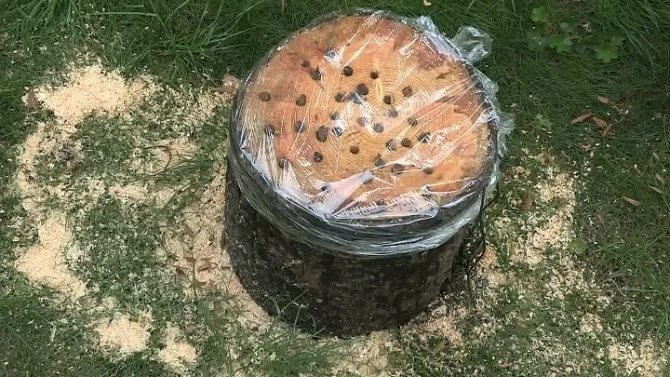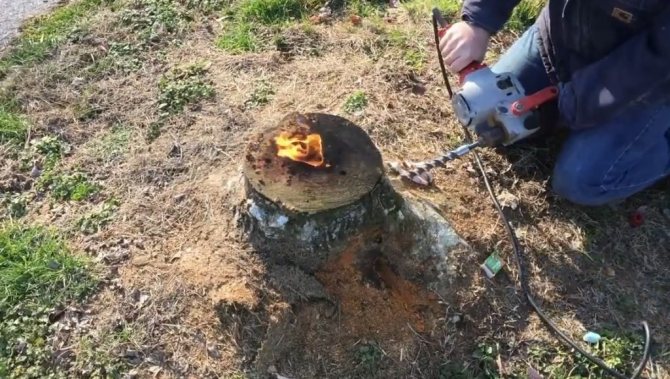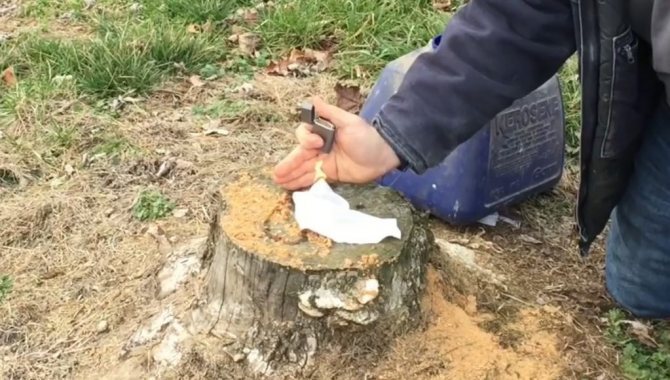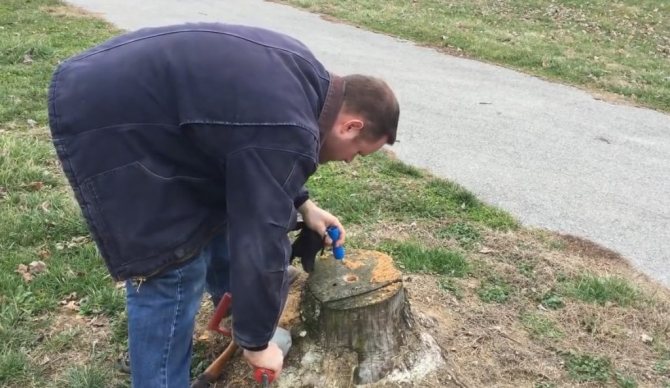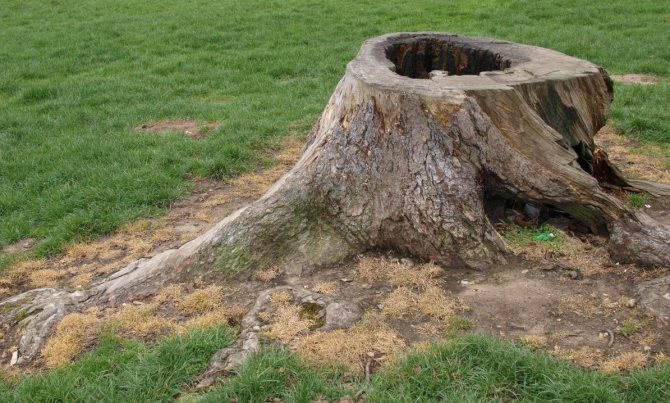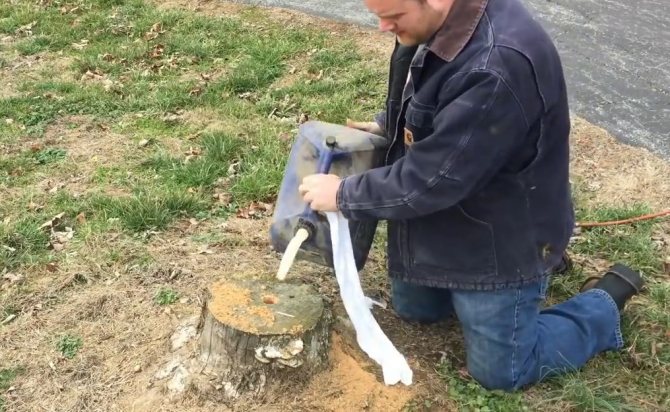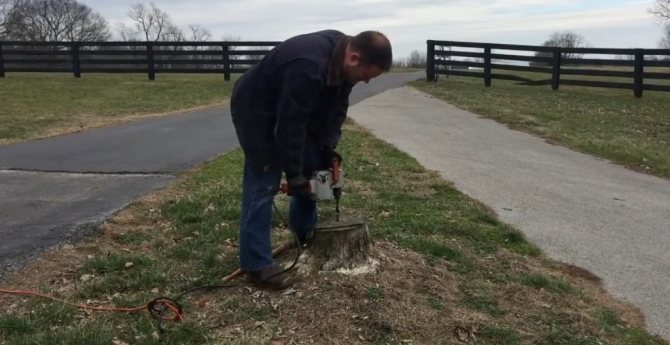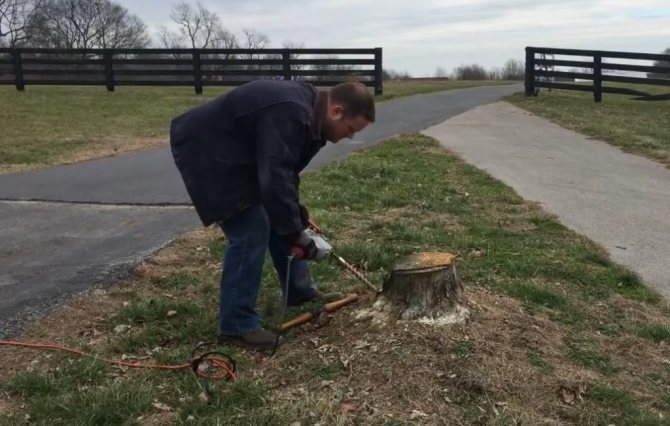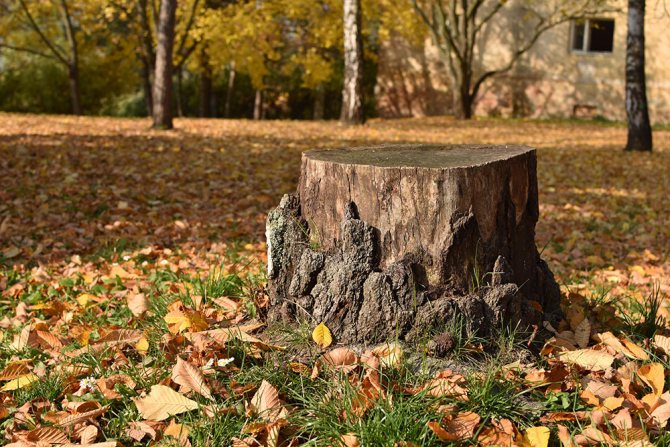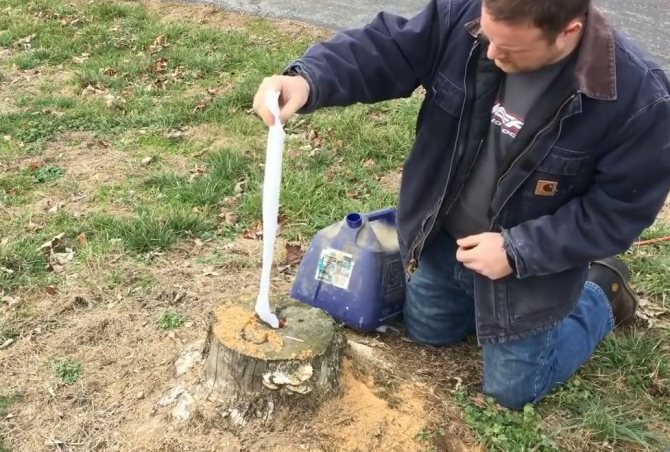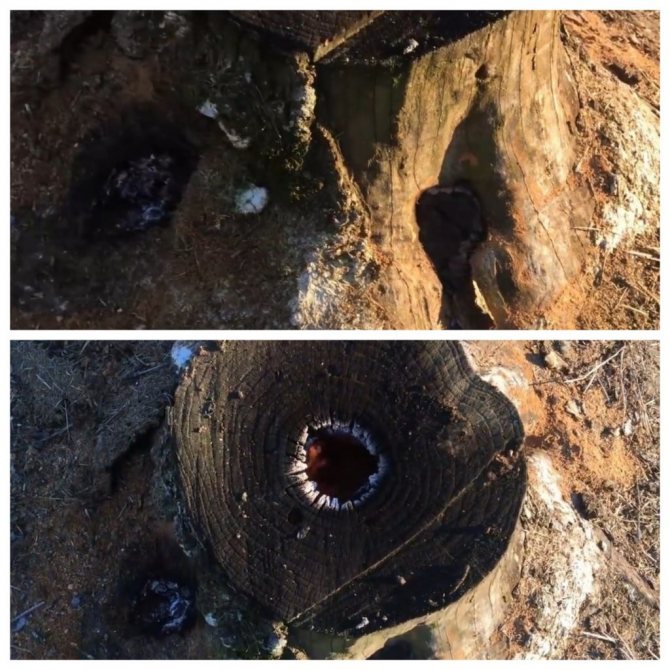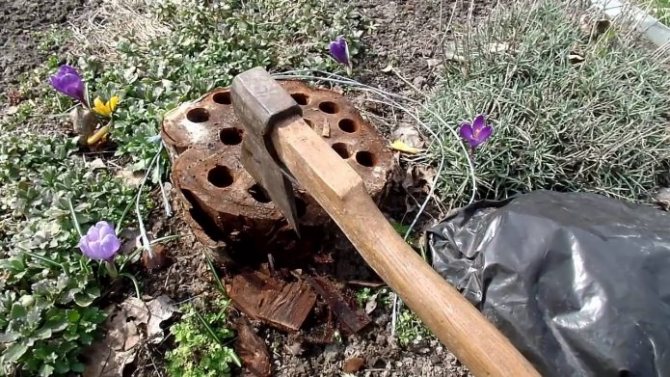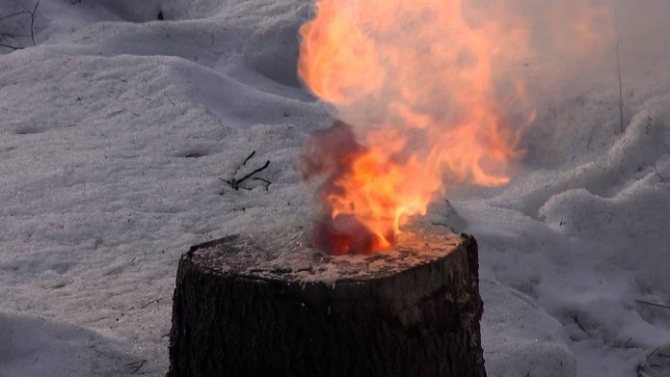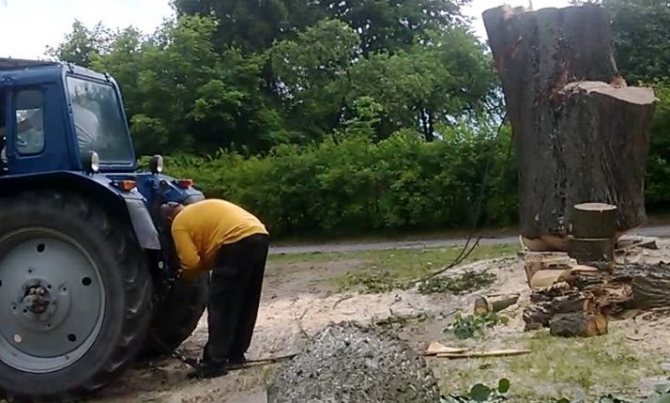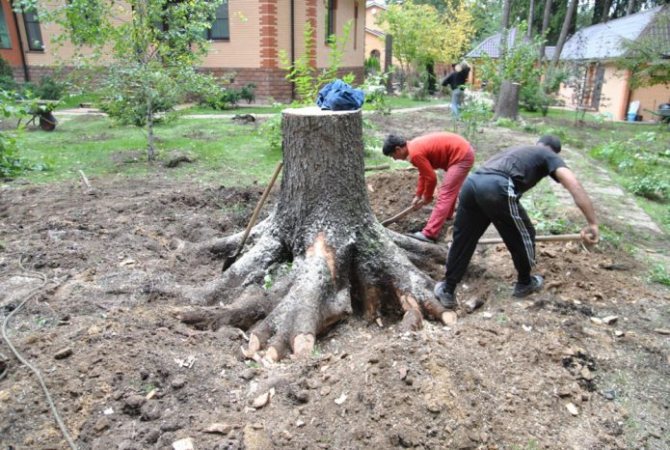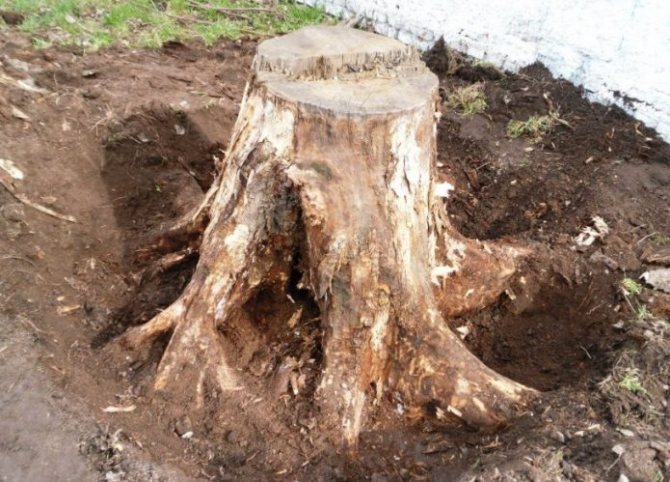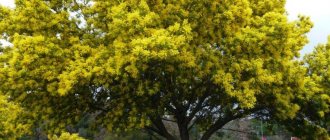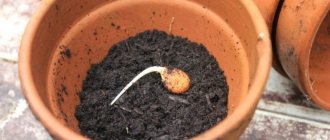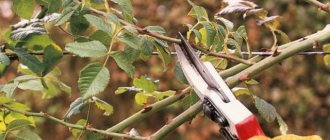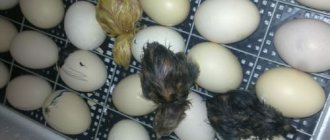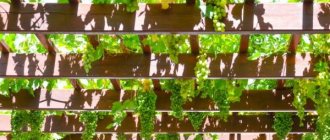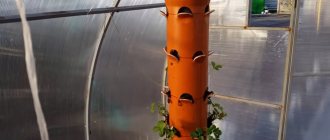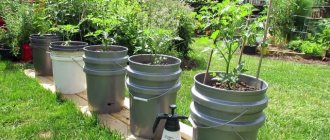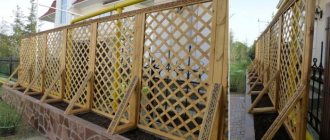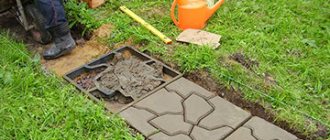Home »Building a house» Do it yourself
Do it yourself
Alexander Korovaev
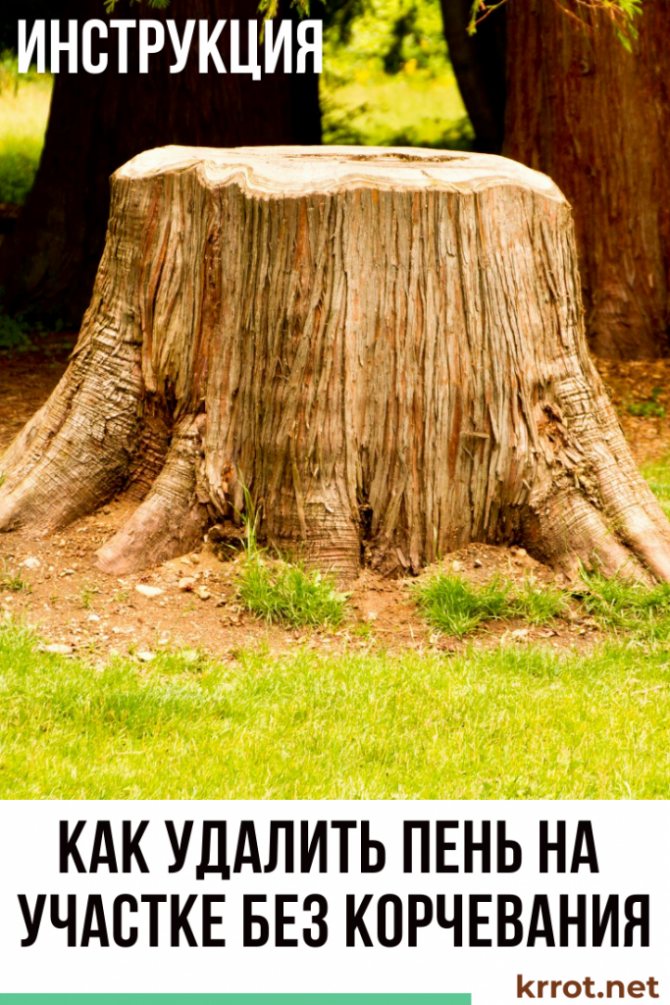
There is a stump on the personal plot - does it spoil the appearance and bother everyone? It would be necessary to uproot it, but somehow my hands do not reach. Painfully, this is a troublesome occupation. This is not true!
You can even remove it without using any axes or shovels, but only fire. In this way, you can remove far from one or two stumps, while spending one or two hours of your precious time.
There is only one drawback of this technique - it cannot be used in those places where there is a risk of fire, i.e. near gas pipelines, storage facilities for fuels and lubricants and in close proximity to residential and outbuildings.
See also: How to embody interesting ideas for decorating your favorite summer cottage - 150+ original photo tips for craftsmen
How to get rid of a tree stump using reagents
The remains of trees take up free space that can be taken away under a garden bed or flower garden. They do not look aesthetically pleasing and give the cottage a neglected look. You can stumble and fall over the stumps. They harbor fungi that pose a risk to the vegetation in the garden.
Engaging special equipment is expensive and inconvenient. This is possible only if the site is spacious, there are no buildings and young trees on it. Since the method is expensive, it is worth resorting to it only if you need to get rid of a dozen stumps.


You can get rid of the stump without uprooting
Cutting hemp with a chainsaw is unreliable - after a while, young shoots will appear. The surest way to get rid of a tree stump is to uproot it. It doesn't always fit. Sometimes it is difficult to approach the appendix due to nearby buildings or flower beds. Uprooting by hand takes a lot of time and effort. This method is deprecated.
They often resort to various methods to forget about the problem. Chemical reagents will be used:
- kitchen salt;
- saltpeter;
- urea.
They destroy the woody structure.
First, the stump is examined, it is cut off to a ball of soil or lower, then the optimal method of removal is selected, evaluating its rationality.
How to use saltpeter
The use of chemicals requires strict adherence to the conditions of the procedure and special skills. You can buy a substance useful in the household at a gardening store. Saltpeter is used as follows. A couple of holes 1 cm wide and up to 40 cm deep are cut out in the stump. 100 grams of potassium or sodium nitrate are poured into them. In order for the substance to work better, it is drowned in water. It usually takes up to 2 kg of saltpeter to remove one stump. The optimal time for the procedure is the beginning of autumn.
Important! It is impossible to use saltpeter in peat areas, as there is a high risk of fire. Better to apply it on areas intended for buildings - it will work faster than other chemicals.
Then plugs should be inserted into the holes, and the stump should be “dressed” in a polymer film. This will prevent the nitrate from washing out in the rain. The stump should be left alone until spring. In a few months, the substance will act on it, the roots will die off. When this happens, you should pour gasoline or another burning mixture into the holes, and throw a match there. Saltpeter in a fire releases oxygen, which contributes to the destruction of not only the stump itself, but also its root system.
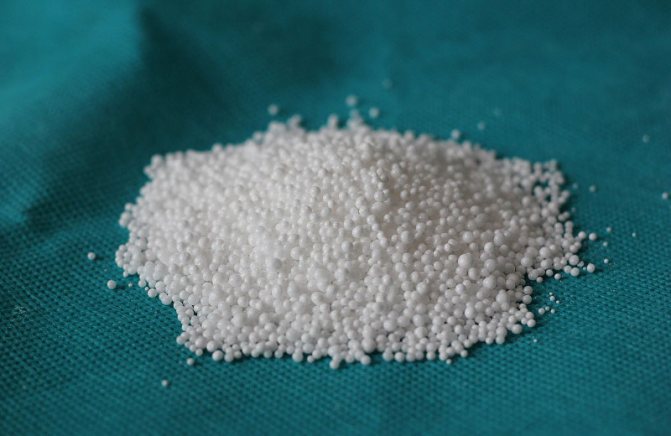

Saltpeter, although useful for the soil, degrades its quality in large volumes. After manipulating saltpeter, the land will be of little use for planting vegetables or flowers in the next few years.
Before using nitrate, you need to transplant plants located around the skeleton at a distance of 0.5-1 m, otherwise they may suffer.
Urea against stumps
It should be used in the same way as saltpeter. Compared to it, urea contains a third more nitrogenous substance. Urea is poured into the holes made in advance, sprinkled with a ball of soil, wait for a while. The main advantage of the reagent is that, unlike saltpeter, it does not cause the slightest harm to the soil. A year later, firewood is laid out on the stump and set on fire. Wood impregnated with the substance will burn quickly enough. Combustion takes place at a depth of up to two meters.
When the stump is destroyed, a pit will form in its place. After that, any tuber or fruit crop can be planted in it. The remains of wood can be removed not only by burning, but also by hand using a crowbar and a shovel. Since the tree will become loose, it will be easier to remove it.
From the complexities of the method, the duration of its implementation (almost two years), as well as the need to use the reagent in large quantities, are distinguished. You need to make 30 holes with a diameter of 1 cm, and fill them with 1 kg of urea.
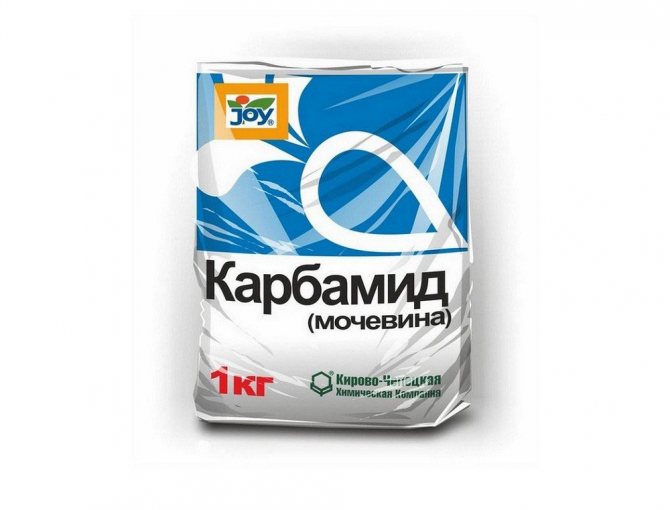

Urea can be safely used on peat soil, where saltpeter cannot be used due to the fire hazard of peat land
Using salt
A practical and inexpensive way to get rid of a tree stump is to use regular salt. You will have to spend a minimum of money. You need to take 300 g of salt, put it in the holes in the stump, pour water on top and sprinkle it with soil. The waiting time is at least 18 months. The disadvantage of this method is that after the procedure, it will not be possible to plant any plants at a distance around the stump for a long time - it will become salty and unusable.
Important! It is advisable to resort to chemical methods if no crops are planned to be planted on the site in the next couple of years.
Roundup
No less effective reagent is Roundup. Although it is produced to get rid of weeds, it can also help with unnecessary skeleton on the site. The stump is doused with a substance and wrapped with foil for the winter so that the rains do not wash it out. After a while, the roots rot and become soft for uprooting. It is advisable to apply the method as soon as the tree was cut down.
Security measures
It is imperative to take care of the means of protection. Wear unnecessary clothing and protective hand gloves. When using urea, you can not be too careful, but you should not take the substance with your bare hands.
If the stumps have been treated with chemicals, and tubers or fruits grow around them, it is best not to eat them. The optimal time for procedures with chemicals is the end of summer or autumn, when the crop is harvested.
Alternative methods for getting rid of a tree stump
Burning is the easiest way to get rid of a tree stump. It harms the growth of new shoots, does not require strength, and gives a guaranteed result. But it also has side effects. If you just overlay the frame with wood and set it on fire, only the part that is above the ground or at a depth of 3-5 centimeters will burn. To make burning more effective, you can overlay the roots with a tree, having previously dug them out. Their size should be the same as the diameter of the appendage at the bottom.
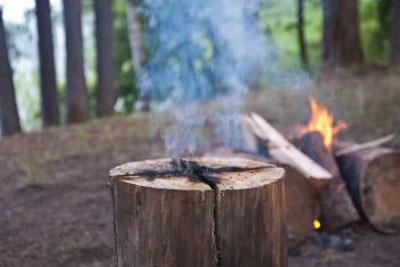

Burning does not give full confidence that the problem can be forgotten. The tree burns for a long time, and the lateral roots remaining underground often give rise to growth
Important! When using open flames, safety precautions should be strictly followed. The coals can re-ignite within 10-15 hours after the procedure. It is not recommended to use gasoline, as well as to do combustion in windy weather.
The next method is used before the onset of cold weather.The stump is well watered. When the frost hits, it will freeze, leading to the destruction of the tree. It will not be difficult to remove a rotten object from the ground.
Gardeners often resort to the following method. Cuts are made on the stump with a knife, sprinkled with mushroom spores (you can take mycelium of honey agarics or oyster mushrooms). You can buy it in a specialized store. Mushrooms will "eat away" all sugar-containing substances from the stump.
Another article:
Summer pruning of apple trees
Preparation is required to lay the mycelium. First, holes are drilled in the stump with a diameter of 5-20 mm and a depth of 3 cm. After that, they are plentifully watered with water for several days. It is better to use spring water, and not chlorinated water - because of it, mycelium can get sick. The mycelium is placed in the holes (1 teaspoon in one hole), poured over it with water and covered with clay or plasticine. Once a week, a new mycelium is watered so that it grows. The first harvest can be seen already six months later.
In two years, the remains of the tree will be destroyed, and a field of mushrooms will appear on the site, from which it will be possible to have a harvest for five years. When the mycelium stops bearing fruit, the skeleton is destroyed without effort. The method is good because when using it, there is no overgrowth from old roots. It is best used for freshly sawn trees - they have more nutrients.
Often, machine oil is used to get rid of the stump. With the onset of heat, it is dug in, making a hole five centimeters deep. The stump is peeled from the bark, and well doused with machine oil. The bark is attached in place, sprinkled with soil on top. In two or three years, it will collapse.
Use of urea or salt.
The essence of the method is to impregnate the stump with substances that contribute to its accelerated decay. After the stump turns into dust, it can be easily uprooted with a regular crowbar or simply smashed with a sledgehammer or ax.
This method is also quite time consuming. It will take about 1-1.5 years for the stump to rot.
Common salt (sodium chloride), urea (carbamide) or potash (potassium carbonate) are used as active substances.
It should be understood that salt causes local (surface) soil salinization. And subsequently, any plant is unlikely to grow in this place.
To apply this method, you need to perform all the steps as when impregnating the stump with nitrate. That is, you need to drill holes in the stump, then pour the active substance into them, pour a little water and cover with polyethylene.
Original ways
If the tree stump is in porous soil in your garden, you can remove it by eroding the soil. The skeleton is dug in from all sides with a shovel. A few steps away from it, they make a hole half a cube deep. They take out a hose with a strong pressure of water and direct it to the bottom of the stump. Wet soil will drain into a pre-made hole. In a day, when all the liquid drains, and the roots appear outward, you can carefully cut them off with a hacksaw. The pit is covered with the same excavated earth. If the area is open, the method is perfect.
Often, gardeners use another original method. They plant young trees directly into the stump. The frame is shortened at the root, a hole is made in the center. For this, you can use a drill. Fertilizer is laid in the recess - peat, ash, humus, sand, manure. A seedling is planted in the hole, which will take nutrients for growth from the old stump.
Blasting is also distinguished among non-standard methods. It must be done by a person who has permits for such work and special equipment. Before laying the charge, a tunnel or a hole is created. They are made either with a drill or manually with a shovel. The required amount and type of explosive can only be prescribed by an explosive technician.
Important! Removing stumps of hard trees - aspen, oak, is more difficult than others.
In order not to waste time and energy, you can invite specialists who will help you quickly solve the problem. Arborists use a milling machine. You can buy a special stump grinder. The tool is capable of destroying wood at a depth of 40 cm. It does it carefully, using milling, without touching the roots of greenery growing nearby. You can forget about the problem in an hour. The disadvantage of this method is the high cost of renting or buying a tool.
When to do the uprooting
There are situations when you have to uproot a tree. These include:
- Clearing the site for plowing. If the tree had a sprawling root system, it could damage the tractor in a collision with machinery. Rooting is necessary if there is a possibility of root growth horizontally at a low height.
- Damage to the tree by root diseases. Pathogens live in the infected roots, so it is necessary to carry out sanitary cutting.
- Planned construction in the country. The use of chemical reagents does not always give the desired result. If the root system is large, it will absorb a lot of liquid. If the stump is located close to the surface of the earth, and immediately on top is concrete, then in winter the water in the cut will become ice and swell. This will contribute to the heaving of the earth and the splitting of the concrete.
- Preparation for planting fruit crops in an area with wild bushes. If you do not remove the entire root of such a plant, it will sprout next year. In this case, chemicals cannot be used, as they affect the quality of the soil and can impair the growth of new seedlings.
Removing the remains of a tree is a tricky task. The method for removing the carcass should be selected based on the planting of the site, the size of the cut, the zone of its location. If you can't get rid of it quickly, you need to think about how to use it as a decorative item in the garden. This trick is used by many summer residents who do not want to waste time and effort on difficult work. Landscape designers make garden tables, benches, small flower beds, rutaria from skeletons.
Mechanized lifting
If a plot of land needs to be cleared of a large number of stumps for future development or gardening, it is better to use heavy equipment - a tractor, bulldozer, truck crane. Especially if there is no danger of damaging any elements of the landscape design.
To remove the above-ground part of the stump, an electric or chainsaw is suitable. This option is cheaper, but without removing the root system of the dead tree, the site cannot be planted or built up.
Many owners use a rented stump grinder. It is also best used when you need to remove a large number of stumps.
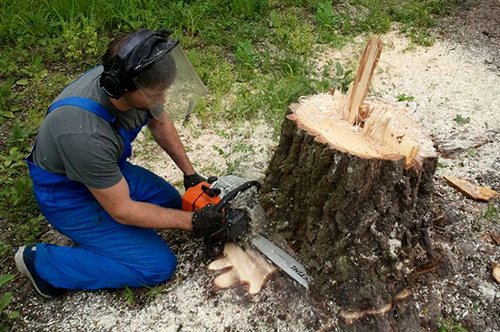

The above-ground part of the stump is cut off with a chainsaw.
If you need to free the area from 1-2 stumps, it is better to use other methods. The attraction of technology in such a situation will be unreasonably expensive. In addition, equipment, especially heavy construction equipment, can damage various elements of landscape design.
Removing stumps is not as difficult as it seems. The main thing is to competently approach the solution of this problem: to get an idea of the root system of various trees, choose the appropriate method of uprooting, prepare everything you need - tools, materials, substances.
To successfully remove stumps without extra effort, you need to find out:
- age, species and type of tree;
- type and depth of the root system;
- the location of the main roots.

